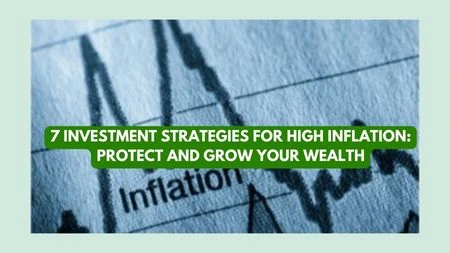No products in the cart.
Stock Market
7 Investment Strategies for High Inflation: Protect and Grow Your Wealth
7 Investment Strategies for High Inflation: Protect and Grow Your Wealth

High inflation can erode the purchasing power of your money and diminish the value of your investments. In an environment where prices are rising rapidly, investors need to adopt strategies that not only protect their wealth but also allow it to grow. In the Philippines, where inflation can be a concern, it’s essential to employ investment strategies that are resilient to inflationary pressures. Here are seven investment strategies to help you protect and grow your wealth in times of high inflation.
1. Invest in Real Assets
Real assets, such as real estate, commodities, and infrastructure, offer a reliable hedge against inflation due to their tangible nature and intrinsic value. As inflation rises, the prices of these assets tend to increase, helping preserve purchasing power and providing potential returns.
- Real Estate: Property values and rental income typically rise with inflation, making real estate a natural hedge. In the Philippines, the demand for residential, commercial, and industrial properties remains strong, particularly in urban centers like Metro Manila, Cebu, and Davao. Investing in rental properties allows investors to benefit from both capital appreciation and a steady income stream, as rent prices can be adjusted to keep pace with inflation. For those seeking a more accessible option, Real Estate Investment Trusts (REITs) provide exposure to the real estate market without the need to manage properties directly.
- Commodities: Commodities such as gold, silver, copper, and oil tend to appreciate in value during inflationary periods. Gold, in particular, is often viewed as a “safe haven” asset during economic uncertainty, preserving wealth as currency values decline. Investing in commodity-focused mutual funds or exchange-traded funds (ETFs) can provide diversification and exposure to these inflation-resistant assets.
- Infrastructure: Infrastructure projects, such as toll roads, power plants, telecommunications towers, and water utilities, offer long-term, stable returns. Many infrastructure contracts have inflation-linked pricing mechanisms, ensuring revenue streams remain resilient against rising costs. The Philippine government’s “Build, Build, Build” program has increased opportunities for infrastructure investments, presenting a promising avenue for long-term growth.
By allocating funds to real assets, investors can create a protective buffer against inflation while tapping into consistent income and capital appreciation.
2. Stocks of Inflation-Resistant Companies
Equities remain a compelling investment option during inflationary periods, especially when focusing on companies with pricing power — the ability to pass increased costs onto consumers without significantly reducing demand.
- Consumer Staples: Companies in the food, beverage, and personal care industries offer products that people continue to purchase regardless of economic conditions. In the Philippines, large consumer goods companies like San Miguel Corporation and Universal Robina Corporation (URC) benefit from steady demand, even during inflationary spikes.
- Healthcare: The healthcare sector is inherently resilient to inflation. Demand for medical products, pharmaceuticals, and health services remains stable regardless of economic fluctuations. Investing in healthcare companies provides both stability and potential growth.
- Utilities and Energy: Firms providing electricity, water, and telecommunications are essential service providers with regulated pricing structures that often allow for inflation adjustments. For example, Meralco (Manila Electric Company) can implement rate increases in response to rising operational costs, ensuring steady revenues.
- Dividend-Paying Stocks: Dividend-paying companies offer an additional layer of protection. As companies raise prices and boost profits to keep up with inflation, dividends may also rise, providing investors with a growing income stream. In the Philippines, blue-chip stocks like PLDT and Ayala Corporation have a long history of consistent dividend payouts, making them attractive during inflationary times.
By focusing on these industries and companies with strong fundamentals, investors can build a defensive equity portfolio that holds up well against rising inflation while still offering growth potential.
3. Inflation-Indexed Bonds
Inflation-indexed bonds are an excellent tool for preserving capital during periods of rising prices. These bonds are specifically designed to adjust their principal and interest payments in line with inflation, ensuring that returns keep pace with rising costs.
- Philippine Retail Treasury Bonds (RTBs): The Philippine government regularly issues RTBs, some of which come with inflation-protection features. These bonds are accessible even to retail investors and offer a low-risk way to safeguard capital while earning steady returns.
- TIPS (Treasury Inflation-Protected Securities): While TIPS are U.S. government-issued bonds, Filipino investors can still gain exposure to them through global investment funds or ETFs. These securities adjust both their principal and interest payments according to inflation, providing a guaranteed real return.
- Corporate Inflation-Protected Bonds: Some corporations issue bonds with inflation-linked adjustments. These can provide higher yields than government bonds, though they carry slightly more risk.
Inflation-indexed bonds offer a reliable method of preserving purchasing power while providing consistent income, making them a cornerstone for any inflation-protection strategy.
4. Diversification Across Asset Classes
Diversification is one of the most effective strategies for reducing risk in any investment environment, and it becomes even more critical during inflationary periods. A well-diversified portfolio spreads investments across multiple asset classes, ensuring that no single economic factor — like rising inflation — can significantly damage overall returns.
- Stocks: Offer long-term growth potential and can outperform inflation over time.
- Bonds: While traditional bonds may struggle during inflationary periods, inflation-linked bonds provide stability.
- Real Estate: Delivers rental income and capital appreciation, acting as a reliable hedge.
- Commodities: Provide direct inflation protection as prices for goods like oil, gold, and agricultural products typically rise with inflation.
- Cash or Cash Equivalents: Holding cash in inflationary times may seem counterintuitive, but maintaining liquidity allows investors to seize emerging opportunities. Short-term instruments like money market funds or time deposits offer modest returns while preserving capital.
By building a diverse portfolio that includes growth-oriented stocks, inflation-protected bonds, tangible assets, and liquid reserves, investors can reduce risk while ensuring resilience in the face of inflation.

5. Short-Term Investments
Inflationary environments often coincide with rising interest rates, making short-term investments such as money market funds, certificates of deposit (CDs), and short-term bonds attractive options. These investments offer relatively higher yields compared to cash and provide liquidity that allows you to take advantage of higher interest rates as they become available. However, be mindful of reinvestment risk, as interest rates may continue to rise, affecting the returns on new investments.
6. Tangible Assets
Investing in tangible assets such as collectibles, art, and precious metals can provide a hedge against inflation. These assets have intrinsic value and can serve as a store of wealth during times of economic uncertainty. Collectibles and art, in particular, have the potential to appreciate over time and can offer diversification benefits to your investment portfolio. Precious metals like gold and silver have historically been considered safe-haven assets and can provide protection against currency devaluation and inflationary pressures.
7. Adjustable-Rate Investments
Adjustable-rate investments provide a dynamic way to combat inflation by ensuring that returns automatically adjust to reflect rising interest rates. As inflation climbs, these instruments offer protection by linking their yields to prevailing market rates.
- Floating-Rate Bonds: These bonds pay interest that resets periodically, based on benchmark interest rates. As inflation pushes rates higher, the coupon payments on floating-rate bonds increase, offering a natural defense against declining purchasing power.
- Adjustable-Rate Mortgages (ARMs): For property buyers, ARMs offer lower initial interest rates that adjust periodically. While they can be cost-effective in the short term, borrowers should carefully consider the potential for rising payments as rates increase.
- Dividend Reset Preferred Shares: Certain preferred stocks come with dividend rates that reset at regular intervals, often tied to interest rate benchmarks. This feature makes them attractive during inflationary periods, providing steady income that adapts to rising rates.
- Leveraged Loans: Institutional investors often turn to leveraged loans — loans to companies with floating interest rates. These loans offer higher yields in inflationary environments and are commonly packaged into mutual funds and ETFs that focus on floating-rate instruments.
Conclusion
Navigating high inflation requires investors to be proactive and strategic in managing their portfolios. By diversifying across asset classes, investing in inflation-resistant assets, and focusing on short-term investments with higher yields, investors can protect and grow their wealth in the Philippines. Additionally, inflation-indexed bonds, tangible assets, and adjustable-rate investments offer alternative strategies to hedge against inflation risks and preserve purchasing power over the long term.
In summary, short-term investments, tangible assets, and adjustable-rate instruments offer diverse strategies to combat inflation’s corrosive effects. These approaches align well with other inflation-resistant strategies like investing in real assets, inflation-resistant stocks, inflation-indexed bonds, and diversification across asset classes.
By embracing a multi-faceted approach, investors can shield their wealth while positioning themselves for growth. The Philippine market, with its expanding infrastructure, robust consumer sector, and government-backed financial instruments, presents ample opportunities to implement these strategies effectively. Whether through gold, real estate, floating-rate bonds, or short-term instruments, creating a well-rounded portfolio ensures both resilience and profitability in challenging economic conditions.
READ MORE RELATED BLOGS!
READ MORE AND SHARE!
TSOK Chronicles: Unleashing Passion, Dedication, and Excellence in 2024
2023 Your Practical Wedding Guide
Investments and Finance Ultimate Guide
If you like this article please share and love my page DIARYNIGRACIA PAGE Questions, suggestions send me at diarynigracia @ gmail (dot) com
You may also follow my Instagram account featuring microliterature #microlit. For more of my artworks, visit DIARYNIGRACIA INSTAGRAM


Peace and love to you.